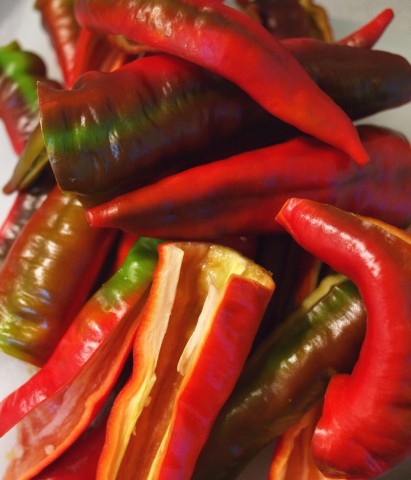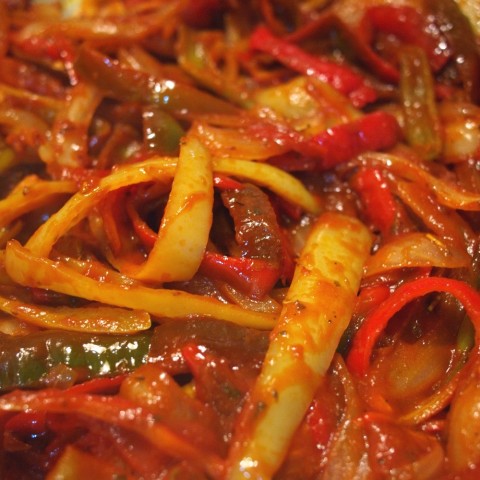Most of the content I’ve posted here so far has come in the form of recipes. But it occurs to me that ninety percent of the cooking that I do is recipe-free. I start with a couple of ingredients that I think would go well together, I cook them up in some predictable way, we eat the results, and more often than not, it is delicious. The preparation isn’t special. But while I sometimes like high-maintenance cooking (as evidenced by almost everything else on this blog), I don’t generally think that preparation should be special. Call me a product of NorCal cuisine if you’d like, but if I had to articulate one cardinal rule of cooking, it would be this:
Use the best, freshest ingredients, don’t do too much, and try your best not to screw them up.
Enter the Nardello Pepper. This, my fine friends, is the best. They’re not very common — Slow Food USA, in fact, has listed them as an “endangered” variety. But they offer an almost-overwhelming fruity sweetness that, when cooked, becomes creamy and complex and unlike any nightshade that I’ve ever eaten before. They’re not un-pepper-like. If anything, they are preternaturally pepper-like. They are more sweet-peppery than the bells, the gypsies, the banana peppers that you usually see around.
I don’t know if they can be found commercially. I have them because Sarah has been growing them in her vegetable garden since we moved to Philadelphia. The seeds come from Southern Italy, and were brought to the United States — to Connecticut, specifically — by the Nardello family in the 1880s. Since 1980 or thereabouts (I am given to understand), they have gotten out and around, and have become increasingly popular with home gardeners. And even if the pepper itself isn’t found for sale very often, the seeds are widely available, including here, at Seeds of Change, and here at the Seed Saver’s Exchange.
I am the opposite of a gardener, I think, which makes me unqualified to talk about the technicalities of how they grow. But every year Sarah plants them, and every year we get good yields. So my impression is that if you want to plant a few, they aren’t that hard to get right.
While I don’t know what to do with them in the yard, though, I know just what to do with them in the kitchen. These peppers were made to be cooked with onions, to be slathered on sandwiches, or draped over pasta. And that is what I would recommend.
I would recommend slicing a large onion, and tossing it into a frying pan with olive oil, dried oregano, fennel seed, salt, pepper, and a small can of tomato paste. Cook until everything (especially the tomato paste) starts to brown, then add sliced Nardellos (along with any other peppers you happen to have). Cook for perhaps ten minutes more until they have softened, then deglaze with a little bit of water (you could use white wine, but remember Rule Number One), and serve with an extruded pasta like ziti.
I sometimes like to add some sliced-up hot Italian sausage to this mix. I’ve also added kale, whole tomatoes, cubes of fresh mozzarella, broccoli, summer squashes, and green beans, all with good results.
Nardellos are special. And if you grow them, that’s a caveat as well as a compliment. You’ll want to grow some other pepper varieties too, because when you’re friends come around asking for produce, and you won’t want to part with any of these.

